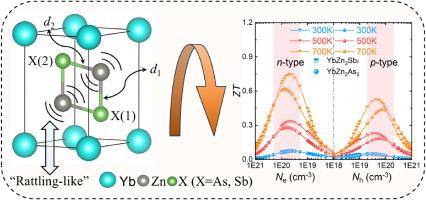使能zintl相YbZn2X2 (X = As, Sb)热电材料的非谐振动和多谷带
IF 9.7
2区 材料科学
Q1 MATERIALS SCIENCE, MULTIDISCIPLINARY
引用次数: 0
摘要
高性能热电(TE)材料的设计需要在内在竞争的电子和热输运特性之间取得微妙的平衡。本文通过第一性原理计算和玻尔兹曼输运理论对Zintl相YbZn2X2 (X=As, Sb)材料进行了全面的理论研究,同时实现了有利的电子输运效率和本质上低的晶格导热系数的良好融合。YbZn2X2 (X=As, Sb)材料在Heyd-Scuseria-Ernzerhof (HSE06)杂化函式下的直接带隙分别为1.23 eV和0.39 eV。弱晶体场效应抑制了价带的分裂,增强了价带简并度。导带具有多谷特性,促进高载流子迁移率和功率因数。此外,声子谱中的平坦色散曲线降低了YbZn2X2 (X=As, Sb)材料的声子群速度,并且Zn原子和不对称Zn-X (X=As, Sb)键的“摇铃式”振动引起了明显的晶格非调和性。这些特性有效抑制了YbZn2As2和YbZn2Sb2在700 K时的晶格热导率分别降至1.59 W/mK和0.94 W/mK。因此,n型掺杂YbZn2As2和YbZn2Sb2材料的ZT分别达到0.62和0.75 @ 700 K,显示了电子结构和声子散射机制的协同优化。值得注意的是,YbZn2Sb2的预测热电性能与实验测量结果非常吻合,证实了计算框架的鲁棒性。这些发现不仅揭示了Zintl相YbZn2As2和YbZn2Sb2材料中电子和晶格动力学之间的基本耦合,而且为下一代高性能TE材料提供了预测设计策略。本文章由计算机程序翻译,如有差异,请以英文原文为准。


Anharmonic rattling vibrations and multivalley bands in enabling Zintl-phase YbZn2X2 (X = As, Sb) thermoelectrics
The design of high-performance thermoelectric (TE) materials requires the delicate balancing of inherently competing electronic and thermal transport properties. In this work, a comprehensive theoretical investigation of the Zintl-phase YbZn2X2 (X = As, Sb) materials is explored through first-principles calculations and Boltzmann transport theory, which simultaneously achieves a favorable confluence of high electronic transport efficiency and intrinsically low lattice thermal conductivity. The YbZn2X2 (X = As, Sb) materials possess direct band gaps of 1.23 eV and 0.39 eV using Heyd-Scuseria-Ernzerhof (HSE06) hybrid functional, respectively. Weak crystal field effects suppress the splitting of valence bands, which enhance band degeneracy. The conduction bands exhibit multi-valley characteristics, promoting high carrier mobility and power factor. Moreover, flat phonon dispersion curves reduce phonon group velocities of YbZn2X2 (X = As, Sb) materials, and “rattling-like” vibrations of Zn atom and asymmetric Zn-X (X = As, Sb) bonds induce pronounced lattice anharmonicity. These characteristics effectively suppress thermal transport, which reduce the lattice thermal conductivities of YbZn2As2 and YbZn2Sb2 to 1.59 W/mK and 0.94 W/mK at 700 K, respectively. Consequently, the n-type doping YbZn2As2 and YbZn2Sb2 materials achieve the dimensionless figure of merits (ZT) of 0.62 and 0.75 @ 700 K, respectively, showing a synergistic optimization of the electronic structure and phonon scattering mechanisms. Notably, the predicted thermoelectric performance of YbZn2Sb2 is in excellent agreement with experimental measurements, affirming the robustness of the computational framework. These findings not only shed light on the fundamental coupling between electronic and lattice dynamics in Zintl-phase YbZn2As2 and YbZn2Sb2 materials, but also provide a predictive design strategy for next-generation TE materials with high performance.
求助全文
通过发布文献求助,成功后即可免费获取论文全文。
去求助
来源期刊

Materials Today Physics
Materials Science-General Materials Science
CiteScore
14.00
自引率
7.80%
发文量
284
审稿时长
15 days
期刊介绍:
Materials Today Physics is a multi-disciplinary journal focused on the physics of materials, encompassing both the physical properties and materials synthesis. Operating at the interface of physics and materials science, this journal covers one of the largest and most dynamic fields within physical science. The forefront research in materials physics is driving advancements in new materials, uncovering new physics, and fostering novel applications at an unprecedented pace.
 求助内容:
求助内容: 应助结果提醒方式:
应助结果提醒方式:


